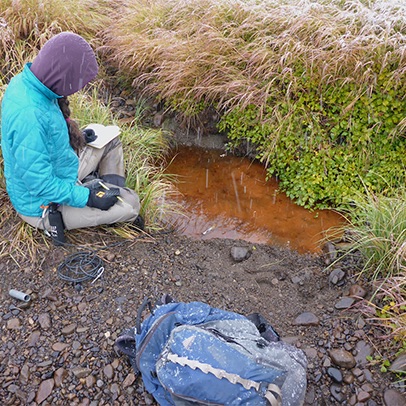Iron-eating bacteria play important role in Arctic tundra and on carbon cycle
 Summer research assistant Frances Iannucci takes measurements and prepares to collect samples. The mineral soils are underlain by permafrost constraining the movement of surface water that creates conditions ideal for the oxidation and reduction of iron. Microbial mats dominated by iron-oxidizing bacteria can form in pools (shown here), small ponds and wet sedge meadows. These iron mats have the potential to influence biogeochemical processes in the tundra by acting as a source of primary production. The iron oxides can also act as terminal electron acceptors for bio-mineralization coupled to iron reduction; furthermore, the iron cycle may play an important role in controlling phosphorus dynamics. Courtesy of Joshua Benes/University of Vermont
Summer research assistant Frances Iannucci takes measurements and prepares to collect samples. The mineral soils are underlain by permafrost constraining the movement of surface water that creates conditions ideal for the oxidation and reduction of iron. Microbial mats dominated by iron-oxidizing bacteria can form in pools (shown here), small ponds and wet sedge meadows. These iron mats have the potential to influence biogeochemical processes in the tundra by acting as a source of primary production. The iron oxides can also act as terminal electron acceptors for bio-mineralization coupled to iron reduction; furthermore, the iron cycle may play an important role in controlling phosphorus dynamics. Courtesy of Joshua Benes/University of Vermont
 Summer research assistant Frances Iannucci takes measurements and prepares to collect samples. The mineral soils are underlain by permafrost constraining the movement of surface water that creates conditions ideal for the oxidation and reduction of iron. Microbial mats dominated by iron-oxidizing bacteria can form in pools (shown here), small ponds and wet sedge meadows. These iron mats have the potential to influence biogeochemical processes in the tundra by acting as a source of primary production. The iron oxides can also act as terminal electron acceptors for bio-mineralization coupled to iron reduction; furthermore, the iron cycle may play an important role in controlling phosphorus dynamics. Courtesy of Joshua Benes/University of Vermont
Summer research assistant Frances Iannucci takes measurements and prepares to collect samples. The mineral soils are underlain by permafrost constraining the movement of surface water that creates conditions ideal for the oxidation and reduction of iron. Microbial mats dominated by iron-oxidizing bacteria can form in pools (shown here), small ponds and wet sedge meadows. These iron mats have the potential to influence biogeochemical processes in the tundra by acting as a source of primary production. The iron oxides can also act as terminal electron acceptors for bio-mineralization coupled to iron reduction; furthermore, the iron cycle may play an important role in controlling phosphorus dynamics. Courtesy of Joshua Benes/University of Vermont
Iron may play a much larger role in the biogeochemistry of the Arctic tundra than previously thought, with the potential to impact ongoing climate change. Bigelow Laboratory scientists were the first to discover and report on microbial iron oxidation in the tundra and how iron-oxidizing bacteria may impact the Arctic’s response to rising temperatures. Their findings were published in Applied and Environmental Microbiology.
“The Arctic tundra has the potential to be heavily affected by changes in climate associated with increased atmospheric carbon dioxide concentrations and global warming,” said Dave Emerson, lead author of the study and senior research scientist at Bigelow Laboratory. “Its permanently frozen soils – or permafrost – hold an enormous amount of organic carbon, which when released could increase greenhouse gases, including methane. An active, microbially-mediated iron cycle could serve to keep a check on methane emissions.”
“We discovered iron-oxidizing bacteria are common in tundra wetlands and produce copious amounts of biogenic iron oxides. These oxides are easily reduced by an anaerobic, iron-reducing bacteria that live deeper in the tundra soils. Microbial iron-reduction will outcompete the process of methanogenesis carried out by a different group of microbes responsible for methane production.
“The net affect would be to suppress methane production. The reduced iron that comes from iron-reduction will keep feeding iron-oxidizing bacteria. Because the permafrost layer in the tundra is often only a few tens of centimeters below the soil surface, this process limits the downward flow of anoxic iron-rich waters, and keeps everything close to the surface. This intensifies the iron cycle.”
Researchers conducted their investigation on the North Slope of Alaska, near Toolik Field Station at Toolik Lake, where they sampled 10 sites, nine of which contained microbial iron mats. Some of these mats covered hundreds of square meters. In addition to possibly suppressing methane production, the presence of iron oxides may also play an important role in the phosphorus cycle. Phosphorus is often an important controlling nutrient in tundra ecosystems that limits overall primary productivity and fixation of carbon dioxide. Phosphorus binds strongly to the iron oxides produced by the bacteria, and it is not known how may control its availability to plants and other microbes.
Since this was the first discovery of iron-oxidizing bacteria in the tundra, more investigation is needed to ferret out their numbers, location, and to better determine their role in maintaining the delicate planetary balance.
In addition to Emerson, other co-authors of the paper are: Jarrod Scott, also a Bigelow Laboratory scientist, and Joshua Benes and William B. Bowden, from the Rubenstein School of Environment and Natural Resources, University of Vermont.
The full paper can be read here: http://aem.asm.org/content/81/23/8066.full.pdf+html.
Event Date
Address
United States






















